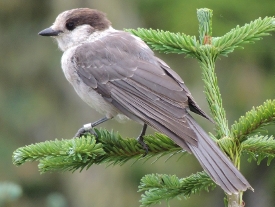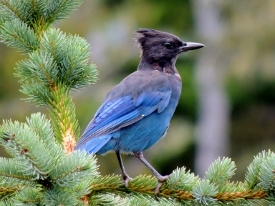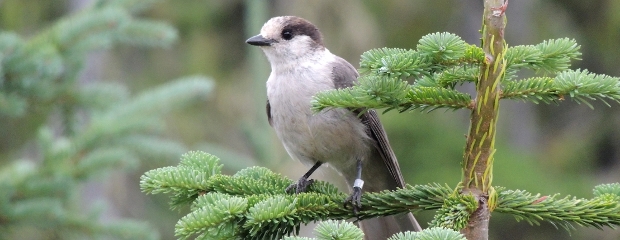MARS Moment 2013
by Sandy Fairfield, MARS Education Coordinator
One of my favorite pastimes in the summer months is to visit and enjoy the many treasures found in Strathcona Park and Mount Washington. This year the area has provided a retreat from the long hot summer days, providing cooler breezes and respite from the sun among the trees. With only a few more weeks of summer it is a great place to take the family to picnic or hike the trails; the area around the Raven Lodge is easily accessible to those who are not able to hike steep areas, the Paradise meadow area provides a few kilometres of boardwalk. The boardwalk trail winds through shallow mountain lakes among the wildflowers, many of which have identification tags. The park is also home to many wildlife species; some take advantage of the cooler elevation in the summer months, escaping the hot urban areas, others are year round residents that are equipped to live in remote areas during harsh winter conditions.
We are fast approaching the critical time when non-migratory birds are gathering and storing their winter food supplies. Fearless, adventuresome, inquisitive and sometimes too friendly, the Gray Jay or “Whiskey Jack” is one of the most common all year residents that can withstand the harsh winter weather. At the start of the trails to the meadows and the upper hiking trails there is an information hut that also has a board to alert users of up to date wildlife sightings, it also reminds visitors not to feed wildlife. Gray Jays are part of the “corvid” family that includes Stellar Jays, crows and ravens; all of these birds are highly intelligent and will remember where they find an easy source of food.
Found predominately in coniferous forests, Gray Jays prefer balsam and fir trees. Similar in size to a robin, Gray Jays are designed to manoeuvre through the forest with great agility. Their short, rounded wings and elongated tails allow them to make abrupt changes in direction; strong feet and legs provide clinging power, enabling them to hang upside down on tree trunks. As their name suggests, their plumage is predominantly shades of gray, with light bodies, dark heads, pearl gray throats, cheeks, and breasts. Their black beaks are surrounded by gray “whiskers”; lustrous brown eyes are highlighted in dark gray and, unlike the Stellar Jay, they do not have the crested head feathers. These jays have exceptionally dense, downy feathers that insulate them against extreme weather conditions. Appearing silently out of the forest, they hop from branch to branch before announcing their presence with loud raucous chattering.
On my last visit a few weeks ago I saw several family groups who had made their trek with these birds in mind, having brought along special food for them. Gray Jays have been a constant companion of skiers and hikers and old homesteaders who were known to befriend these birds. However, with ever increasing visitors to these areas, the jays are becoming more of a nuisance due to well meaning people wanting to hand feed them. They are becoming aggressive, begging for food and stealing anything that is set down on the ground; I counted a group of ten jays that were relentless in their begging. Natural food for these birds includes insects, berries, nuts and seeds and any carrion they may find – they cannot survive on crackers, cookies or bread. Jays have extra large mouths and are able to hold several mouthfuls of food which they take back to the trees or crevices in the rocks. The food is wrapped in saliva before being stored in their winter “larder”. Feeding these birds junk food with no nutritional value can result in starvation before the winter is out.
 Although it is against the wildlife act to feed wildlife, this is not commonly known. If you do feed a bird make sure that it is something they would naturally eat, not food that is going to be detrimental to their health. It is also a good thing to remember that birds do carry diseases that can pass to humans and I see so many people sharing their sandwiches with the birds without washing their hands! In the next few weeks wildlife will be starting to gather and store food and also start to work on increasing their body fat in preparation for the winter, especially the migratory birds. Please stay away from areas where wildlife is feeding, it can make the difference between life and death before they reach their destination. Fall is also a beautiful time to visit the Mount Washington area before the snow falls, please help keep our wildlife “wild”. For more information or to report injured wildlife, please call MARS at 250-337-2021.
Although it is against the wildlife act to feed wildlife, this is not commonly known. If you do feed a bird make sure that it is something they would naturally eat, not food that is going to be detrimental to their health. It is also a good thing to remember that birds do carry diseases that can pass to humans and I see so many people sharing their sandwiches with the birds without washing their hands! In the next few weeks wildlife will be starting to gather and store food and also start to work on increasing their body fat in preparation for the winter, especially the migratory birds. Please stay away from areas where wildlife is feeding, it can make the difference between life and death before they reach their destination. Fall is also a beautiful time to visit the Mount Washington area before the snow falls, please help keep our wildlife “wild”. For more information or to report injured wildlife, please call MARS at 250-337-2021.

